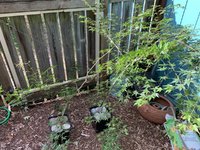NOZZLE HEAD
Shohin
I like the deep black of Biochar as a substrate, but it has some drawbacks from a chemical standpoint.
1. Crazy high CEC
2. It emits ethylene if un-aged.
3. High pH
But do these drawbacks matter when it comes to Japanese maples?
I planted four sapling Japanese Maples I acquired from a nursery in a vacant lot next to a convenience store in 9” by 9” pots.
All fertilizer and pesticides have been the same.
No control per se. I have lots of other Japanese maples, we all know what they do.
My guess as to the difference in color is pH. I am going to treat all four trees with a balanced analysis pH lowering fertilizer today.
Left is 100% biochar. Right is 50/50 biochar and my standard 50/50 pumice/organics mix.
1. Crazy high CEC
2. It emits ethylene if un-aged.
3. High pH
But do these drawbacks matter when it comes to Japanese maples?
I planted four sapling Japanese Maples I acquired from a nursery in a vacant lot next to a convenience store in 9” by 9” pots.
All fertilizer and pesticides have been the same.
No control per se. I have lots of other Japanese maples, we all know what they do.
My guess as to the difference in color is pH. I am going to treat all four trees with a balanced analysis pH lowering fertilizer today.

Left is 100% biochar. Right is 50/50 biochar and my standard 50/50 pumice/organics mix.


